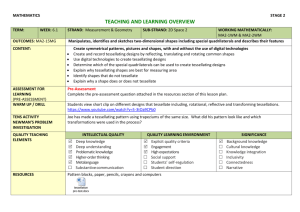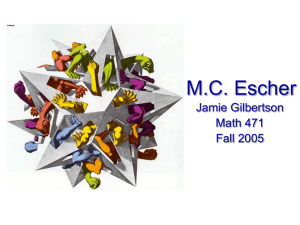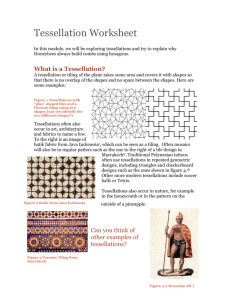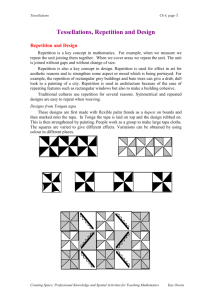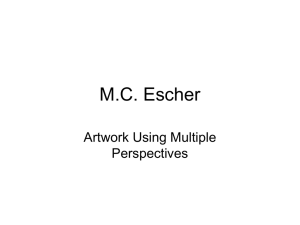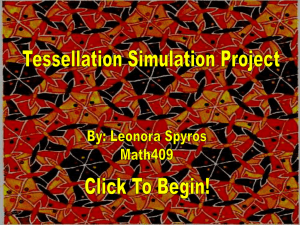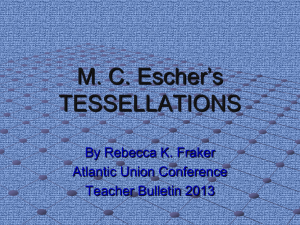Tessellations: Art & Math Presentation
advertisement
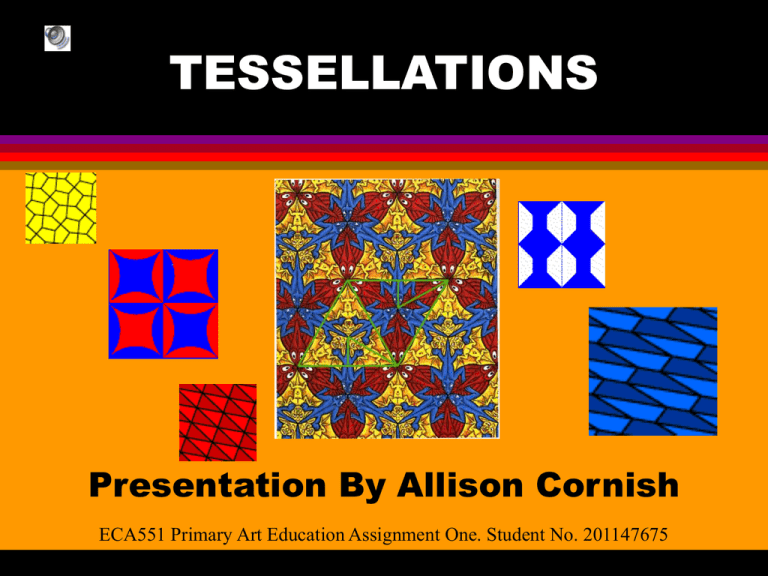
TESSELLATIONS Presentation By Allison Cornish ECA551 Primary Art Education Assignment One. Student No. 201147675 WHAT IS A TESSELLATION? Tessellations are repeating patterns of distinct shapes. A tessellation must follow three rules: This is a true tessellation. It fits all of the 3 rules. •The pattern must be repeated •There must be no gaps or overlaps •The pattern must be able to continue on a plane forever This is a not a tessellation but a pattern. The Images on this page are borrowed from http://library.thinkquest.org/16661/cgi-bin/printpage.cgi WHICH SHAPES TESSELLATE EASILY? Look at these shapes. Which ones do you think will fit together to make a repeating pattern with no gaps? on each shape to find out if they tessellate. CLICK HERE WHEN YOU HAVE FINISHED WITH THE SHAPES Squares YES !!! A Square Shape tessellates really well. What does the first pattern remind you of? Notice that the square pattern doesn’t have to line up to tessellate? GO BACK Triangles YES !!! Triangles can tessellate too. Are all the triangles facing the same way? Why do you think this is? What would happen if they were? Would the shape still tessellate? GO BACK Circles NO !!! Circles don’t tessellate. Why is this? Which rules of tessellation does this pattern break? GO BACK Other Shapes YES !! All of these shapes tessellate. GO BACK Octagon, Pentagon YES ! Notice the octagon leaves gaps in it’s pattern - so it breaks one of the rules of tessellations - but each gap is exactly the same - a diamond. Sometimes two shapes can be joined together to make a tessellating shape. NO ! The Pentagon doesn’t fit together at all! GO BACK TECHNIQUES USED TO TESSELLATE ROTATION R TRANSLATION Angle = 90º R R R Center To rotate an object means to turn it around, Every rotation has a center and an angle. To Translate an object means to move it without rotating it. Every translation has a direction and a distance. Images on this page were adapted from images at http://library.thinkquest.org/16661/index2.html TECHNIQUES USED TO TESSELLATE REFLECTION GLIDE -REFLECTION To Reflect an object means to produce it’s mirror image. Every reflection has a mirror line. A Glide reflection combines a reflection along with a translation along the direction of the mirror line. Images on this page were adapted from images at http://library.thinkquest.org/16661/index2.html ACTIVITY On a piece of paper, draw an example of the four techniques we can use to make a tessellating pattern. ROTATION TRANSLATION REFLECTION GLIDE REFLECTION It might help to use a mirror to check your reflection work !!! HISTORY Tessellations have been around a long time. In 4000 B.C. the Sumerians used them to decorate the walls of their homes and temples . Have a think about what the tessellations may have been constructed from so long ago. Can you guess? They were made from slabs of hardened clay. Throughout history the Egyptians, Moors, Romans, Persians, Greek, Byzantine, Arabic, Japanese, and Chinese have also used tessellations for decoration and in their Art works. Tessellating Art works from these cultures tell us a lot about the lifestyle and culture at the time they were made. For example, the Islamic religion forbids the representation of living objects in works of art. Islamic art works such as the Jam’aa Mosque opposite, use tessellating patterns but never depict human or animal shapes. Notice the diamond shape pattern in the bottom center of this picture. Image borrowed from http://islamicart.com/pages/architecture/decor.htm WHO WAS M.C. ESCHER? Escher is one of the best known Artists to use tessellations in his work, but was he more than an Artist? He was considered a great mathematician too. Maurits Cornelis Escher was born in the Netherlands in 1898. He didn’t do well in most subjects at school and failed his final exams, however Escher did excel in one subject, drawing. His Art teacher taught him how to make linoleum prints and this was the beginning of his great career as an Artist. Later Escher studied Graphic Art and created many incredible works of art. He is most famous for his ‘impossible drawings’ and his tessellations. Escher discovered the tessellating patterns of Moorish Mosaics during a visit to Spain in 1922. A great deal of Escher’s tessellations and geometric works were developed using mathematical techniques. Impossible? Images on this page were found on the Web. See Acknowledgements Page. ESCHER’S TESSELLATIONS Escher uses REFLECTION and ROTATION to create this art work. Can you tell which technique was used first? All Images on this page are borrowed from http://library.thinkquest.org/16661/index2.html ESCHERS TESSELLATION’S Which technique has Escher used to create this tessellation? All Images on this page are borrowed from http://library.thinkquest.org/16661/index2.html ESCHERS TESSELLATION’S Escher has created a new shape staring from a Square. Notice how the top and right-hand-side lines are the same? So are the bottom and left-hand-side lines. This allows the shape to fit together. What would happen if we tried to use different lines to create a new shape? Would they fit together? Try it on graph paper first and then copy the technique Escher has used. All Images on this page are borrowed from http://library.thinkquest.org/16661/index2.html ESCHER’S TESSELLATION’S Notice how Escher has used the ROTATION technique in this Art work. Find the center point. This is the point the shape must rotate around. All Images on this page are borrowed from http://library.thinkquest.org/16661/index2.html ACTIVITIES Make your own tessellating shape from a square. First Cut out a section from the bottom and stickytape it to the top. Do the same for the sides. Cut out different color copies of your shape and stick them to cardboard to form a tessellation. USEFUL WEB SITES TOTALLY TESSELLATED http://www.thinkquest.org/library/lib/site_sum_outside.html?tname=16661&url=16661 TESSELLATIONS WEB QUEST http://www.angelfire.com/ab6/rbrowning/ WHAT ARE TESSELLATIONS http://www.tssp.co.uk/Literature/Tessellations/WhatareTessellations/ ISLAMIC ART http://www.islamicart.com/main/architecture/decorate.html MORE INFORMATION ON TECHNIQUES DISCUSSED IN THIS PRESENTATION http://www.ucs.mun.ca/~mathed/Geometry/Transformations/frieze.html and http://mathforum.org/sum95/suzanne/symsusan.html A HUGE NUMBER OF LINKS ACTIVITIES AND WEB SITE EVALUATIONS CAN BE FOUND AT: http://ccins.camosun.bc.ca/~jbritton/jbsymteslk.htm ACKNOWLEDGEMENTS A large amount of the information for this presentation was adapted for Primary School Students from the web site “Totally Tessellated” (http://library.thinkquest.org/16661). I would recommend this site to any teacher planning to introduce tessellations to their students. Picture and Video Images base of the Friday Mosque "Jam'aa" at Herat in Afghanistan from: Islamic Arts and Architecture Organization, 1995-2001.,‘Islamic Ar t’, <http://islamicart.com/pages/archtcre/décor.htm> (last accessed 24/4/02) All other Picture and Video images from Bhushan, Kay and Williams, n.d. ‘Totally Tessellated’ <http://library.thinkquest.org/16661> (last accessed 24/4/02)



